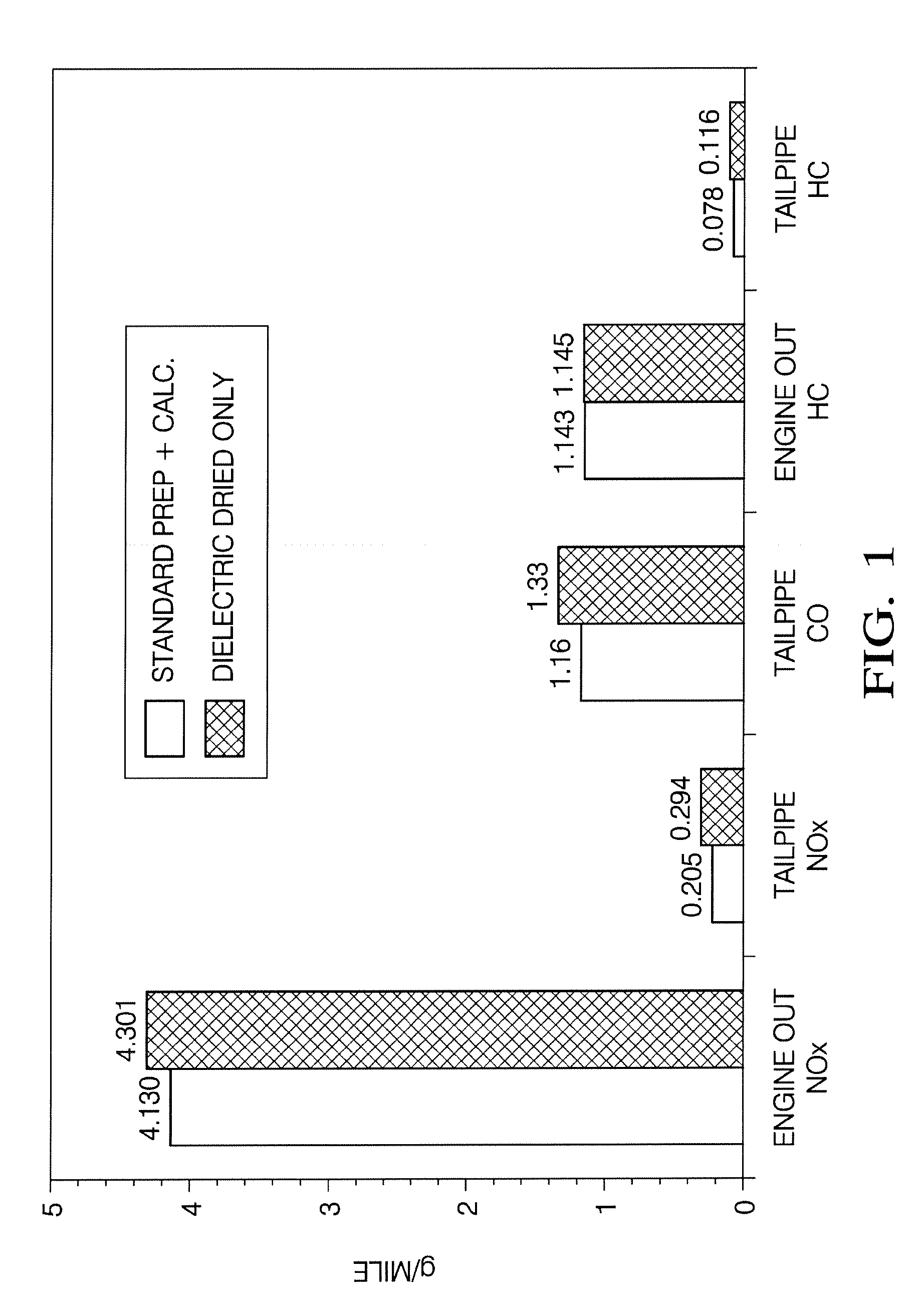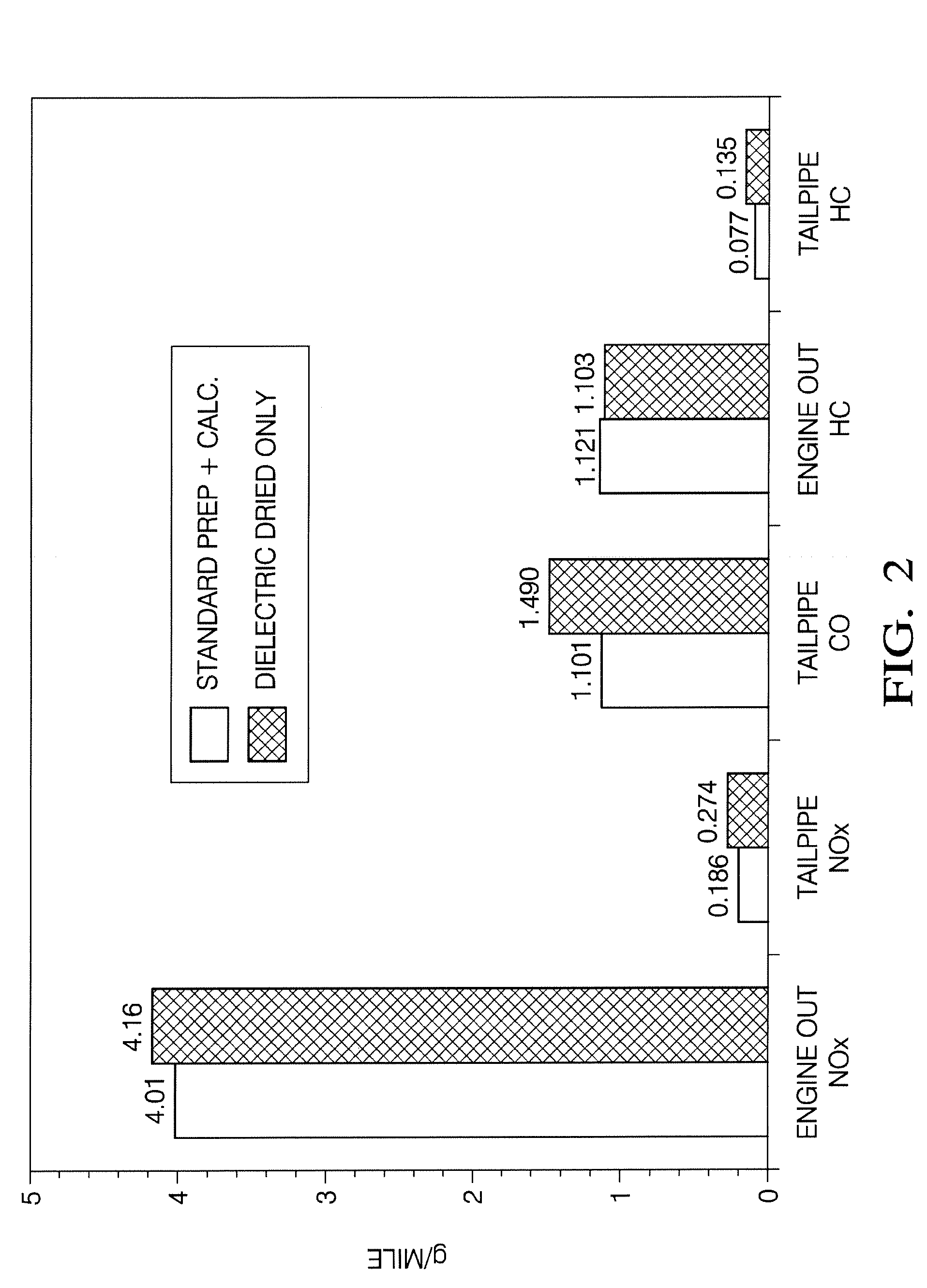Method For Producing A Catalyst And The Catalyst Made Therefrom
a catalyst and catalyst technology, applied in the direction of metal/metal-oxide/metal-hydroxide catalysts, physical/chemical process catalysts, separation processes, etc., can solve the problems of uneven water evaporation, time-consuming and expensive, and the only method of calcining the composition of the catalyst, such as gas fired or electric ovens,
- Summary
- Abstract
- Description
- Claims
- Application Information
AI Technical Summary
Benefits of technology
Problems solved by technology
Method used
Image
Examples
example 1
[0071]In this example, the impact of dielectric drying and calcining via convection on catalyst performance were compared for single layer catalysts wherein the catalytically active metals are platinum and rhodium. Four samples were prepared in accordance with Table 1 wherein the ratio of active platinum to rhodium in the catalyst composition was 3:1 by weight. The platinum plus rhodium loading was 25.0 grams per cubic foot (g / ft3) at 3:0:1. The composition of the catalysts is defined based on total precious metal per geometric volume plus the ratio of the metals in the order of Pt, palladium (Pd), and Rh (Pt:Pd:Rh). Here the Pd was 0 as we have no Pd so the weight ratio is 3:0:1.
TABLE 1SampleCatalytic MetalHeatingTemperature (° C.)No.PrecursorTechniqueand time (hrs)1platinum nitrate / CC1 calcination540° C. for 2 hrsrhodium nitrate2platinum nitrate / RF2 drying; no 80° C. for 15 min.rhodium nitratecalcination3platinum hexahydroxyCC calcination540° C. for 2 min.ethanolamine / rhodiumnitra...
example 2
[0074]In this example, two successive FTP tests were conducted on the electromagnetically dried catalyst composition in order to determine whether the process of undergoing the final calcining step on the vehicle produced any significant difference in emissions between the first FTP test and the second FTP test. The results for Sample 2 are shown in FIG. 3 and the results for Sample 4 are shown in FIG. 4. Both figures show very little difference in engine to tailpipe emissions clearly indicating that electromagnetic drying of the catalyst compositions followed by calcination in the exhaust stream of the vehicle does not result in excessive emissions.
example 3
[0075]In this example, the second-by-second emissions were measured for engine and tailpipe emissions over the first 200 seconds for the first and second FTP tests for non-methane hydrocarbons (NMHC), CO, and NOx for Sample 2 with the results illustrated in FIGS. 5, 6 and 7. In the FIGS. 5, 6 and 7 respectively, data represented by lines “a” represents the first FTP test, tailpipe, line “b” represents the first FTP test, engine out, line “c” represents the second FTP test, tailpipe, and line “d” represents the second FTP test, engine out. While the data reveals a slight increase in the tailpipe emissions for the first FTP test as the temperature increases from about 200° C. to about 500° C., this emission increase is small, namely less than a 3.6% difference when compared to the engine out emissions. This result suggests that during the initial heat up of the catalyst composition to 500° C., the NMHC, CO, and NOx decomposition products of sugar, nitric acid and platinum group metal ...
PUM
| Property | Measurement | Unit |
|---|---|---|
| Temperature | aaaaa | aaaaa |
| Temperature | aaaaa | aaaaa |
| Fraction | aaaaa | aaaaa |
Abstract
Description
Claims
Application Information
 Login to View More
Login to View More - R&D
- Intellectual Property
- Life Sciences
- Materials
- Tech Scout
- Unparalleled Data Quality
- Higher Quality Content
- 60% Fewer Hallucinations
Browse by: Latest US Patents, China's latest patents, Technical Efficacy Thesaurus, Application Domain, Technology Topic, Popular Technical Reports.
© 2025 PatSnap. All rights reserved.Legal|Privacy policy|Modern Slavery Act Transparency Statement|Sitemap|About US| Contact US: help@patsnap.com



